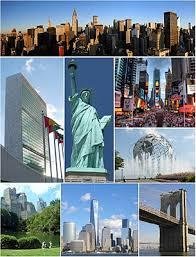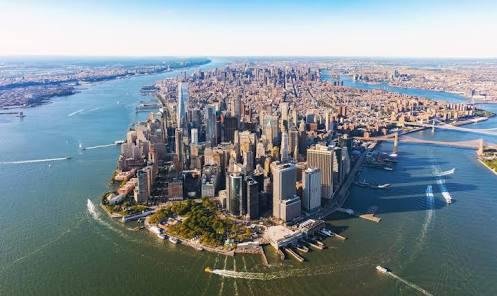The City of New York, often called New York City (NYC) or simply New York, is the most populous city in the United States.[9] With an estimated 2017 population of 8,622,698[7] distributed over a land area of about 302.6 square miles (784 km2),[10][11] New York City is also the most densely populated major city in the United States.[12] Located at the southern tip of the state of New York, the city is the center of the New York metropolitan area, the largest metropolitan area in the world by urban landmass[13] and one of the world's most populous megacities,[14][15] with an estimated 20,320,876 people in its 2017 Metropolitan Statistical Area and 23,876,155 residents in its Combined Statistical Area.[4][5] A global power city,[16] New York City has been described as the cultural, financial, and media capital[17][18] of the world,[19][20][21][22][23] and exerts a significant impact upon commerce,[23] entertainment, research, technology, education, politics, tourism, and sports. The city's fast pace[24][25] defines the term New York minute.[26] Home to the headquarters of the United Nations,[27] New York is an important center for international diplomacy.[28]
Situated on one of the world's largest natural harbors,[29][30] New York City consists of five boroughs, each of which is a separate county of the State of New York.[31] The five boroughs – Brooklyn, Queens, Manhattan, The Bronx, and Staten Island – were consolidated into a single city in 1898.[32] The city and its metropolitan area constitute the premier gateway for legal immigration to the United States.[33] As many as 800 languages are spoken in New York,[34][35][36] making it the most linguistically diverse city in the world.[35][37][38] New York City is home to more than 3.2 million residents born outside the United States,[39] the largest foreign-born population of any city in the world.[40] In 2017, the New York metropolitan area produced a gross metropolitan product (GMP) of US$1.73 trillion.[41] If greater New York City were a sovereign state, it would have the 12th highest GDP in the world.[42]
New York City traces its origins to a trading post founded by colonists from the Dutch Republic in 1624 on Lower Manhattan; the post was named New Amsterdam in 1626.[43] The city and its surroundings came under English control in 1664[43] and were renamed New York after King Charles II of England granted the lands to his brother, the Duke of York.[44] New York served as the capital of the United States from 1785 until 1790.[45] It has been the country's largest city since 1790.[46] The Statue of Liberty greeted millions of immigrants as they came to the Americas by ship in the late 19th and early 20th centuries[47] and is a world symbol of the United States and its ideals of liberty and peace.[48] In the 21st century, New York has emerged as a global node of creativity and entrepreneurship,[49] social tolerance,[50] and environmental sustainability,[51][52] and as a symbol of freedom and cultural diversity.[53]
Many districts and landmarks in New York City are well known, and the city received a record 62.8 million tourists in 2017,[54] hosting three of the world's ten most visited tourist attractions in 2013.[55] Several sources have ranked New York the most photographed city in the world.[56][57] Times Square, iconic as the world's "heart"[58] and its "Crossroads",[59] is the brightly illuminated hub of the Broadway Theater District,[60] one of the world's busiest pedestrian intersections,[61][62] and a major center of the world's entertainment industry.[63] The names of many of the city's bridges, skyscrapers,[64] and parks are known around the world. Anchored by Wall Street in the Financial District of Lower Manhattan, New York City has been called both the most economically powerful city and the leading financial center of the world,[23][65][66][67] and the city is home to the world's two largest stock exchanges by total market capitalization, the New York Stock Exchange and NASDAQ.[68][69] Manhattan's real estate market is among the most expensive in the world.[70][71] New York is home to the largest ethnic Chinese population outside of Asia,[72][73] with multiple signature Chinatowns developing across the city.[74][75][76] Providing continuous 24/7 service,[77] the New York City Subway is the largest single-operator rapid transit system worldwide, with 472 rail stations.[78][79][80] Over 120 colleges and universities are located in New York City, including Columbia University, New York University, and Rockefeller University, which have been ranked among the top universities in the world.[81][82]
History........?
Main articles: History of New York City and Timeline of New York City
Etymology
In 1664, the city was named after the Duke of York, who would become King James II. James's older brother, King Charles II of England, had appointed the Duke proprietor of the former territory of New Netherland, including the city of New Amsterdam, which England had recently seized from the Dutch.
Early history
During the Wisconsinan glaciation, the New York City region was situated at the edge of a large ice sheet over 1,000 feet (300 m) in depth. The ice sheet scraped away large amounts of regolith, leaving the bedrock that serves as the geologic foundation for much of New York City today. Later on, movement of the ice sheet contributed to the separation of what are now Long Island and Staten Island.[83]
In the precolonial era, the area of present-day New York City was inhabited by Algonquian Native Americans, including the Lenape, whose homeland, known as Lenapehoking, included Staten Island; the western portion of Long Island, including the area that would become Brooklyn and Queens; Manhattan; the Bronx; and the Lower Hudson Valley.[84]
The first documented visit into New York Harbor by a European was in 1524 by Giovanni da Verrazzano, a Florentine explorer in the service of the French crown. He claimed the area for France and named it Nouvelle Angoulême (New Angoulême).[85] A Spanish expedition led by captain Estêvão Gomes, a Portuguese sailing for Emperor Charles V, arrived in New York Harbor in January 1525 and charted the mouth of the Hudson River, which he named Río de San Antonio (Saint Anthony's River). The Padrón Real of 1527, the first scientific map to show the East Coast of North America continuously, was informed by Gomes' expedition and labeled the northeastern United States as Tierra de Esteban Gómez in his honor.[86]
In 1609, the English explorer Henry Hudson rediscovered the New York Harbor while searching for the Northwest Passage to the Orient for the Dutch East India Company. He proceeded to sail up what the Dutch would name the North River (now the Hudson River), named first by Hudson as the Mauritius after Maurice, Prince of Orange. Hudson's first mate described the harbor as "a very good Harbour for all windes" and the river as "a mile broad" and "full of fish."[87] Hudson sailed roughly 150 miles (240 km) north,[88] past the site of the present-day New York State capital city of Albany, in the belief that it might be an oceanic tributary before the river became too shallow to continue.[87] He made a ten-day exploration of the area and claimed the region for the Dutch East India Company. In 1614, the area between Cape Cod and Delaware Bay was claimed by the Netherlands and called Nieuw-Nederland (New Netherland).
The first non-Native American inhabitant of what would eventually become New York City was Juan Rodriguez (transliterated to Dutch as Jan Rodrigues), a merchant from Santo Domingo. Born in Santo Domingo of Portuguese and African descent, he arrived in Manhattan during the winter of 1613–1614, trapping for pelts and trading with the local population as a representative of the Dutch. Broadway, from 159th Street to 218th Street in Upper Manhattan, is named Juan Rodriguez Way in his honor.[89][90]
A painting of a coastline dotted with red roof houses and a windmill, with several masted ships sailing close to shore under blue sky.
New Amsterdam, centered in the eventual Lower Manhattan, in 1664, the year England took control and renamed it "New York"
Dutch rule............,
A permanent European presence in New Netherland began in 1624 – making New York the 12th oldest continuously occupied European-established settlement in the continental United States[91] – with the founding of a Dutch fur trading settlement on Governors Island. In 1625, construction was started on a citadel and Fort Amsterdam, later called Nieuw Amsterdam (New Amsterdam), on present-day Manhattan Island.[92][93] The colony of New Amsterdam was centered at the site which would eventually become Lower Manhattan. In 1626, the Dutch colonial Director-General Peter Minuit, acting as charged by the Dutch West India Company, purchased the island of Manhattan from the Canarsie, a small Lenape band,[94] for 60 guilders[95] (about $1,000 in 2006).[96] A disproved legend claims that Manhattan was purchased for $24 worth of glass beads.[97][98]
Following the purchase, New Amsterdam grew slowly.[99] To attract settlers, the Dutch instituted the patroon system in 1628, whereby wealthy Dutchmen (patroons, or patrons) who brought 50 colonists to New Netherland would be awarded swathes of land, along with local political autonomy and rights to participate in the lucrative fur trade. This program had little success.[100]
Since 1621, the Dutch West India Company had operated as a monopoly in New Netherland, on authority granted by the Dutch States General. In 1639–1640, in an effort to bolster economic growth, the Dutch West India Company relinquished its monopoly over the fur trade, leading to growth in the production and trade of food, timber, tobacco, and slaves (particularly with the Dutch West Indies).[99][101]
In 1647, Peter Stuyvesant began his tenure as the last Director-General of New Netherland. During his tenure, the population of New Netherland grew from 2,000 to 8,000.[102][103] Stuyvesant has been credited with improving law and order in the colony; however, he also earned a reputation as a despotic leader. He instituted regulations on liquor sales, attempted to assert control over the Dutch Reformed Church, and blocked other religious groups (including Quakers, Jews, and Lutherans) from establishing houses of worship.[104] The Dutch West India Company would eventually attempt to ease tensions between Stuyvesant and residents of New Amsterdam.[105]



Congratulations @alaminsteem! You received a personal award!
You can view your badges on your Steem Board and compare to others on the Steem Ranking
Vote for @Steemitboard as a witness to get one more award and increased upvotes!
Congratulations @alaminsteem! You have completed the following achievement on the Hive blockchain and have been rewarded with new badge(s) :
You can view your badges on your board and compare yourself to others in the Ranking
If you no longer want to receive notifications, reply to this comment with the word
STOPDo not miss the last post from @hivebuzz: